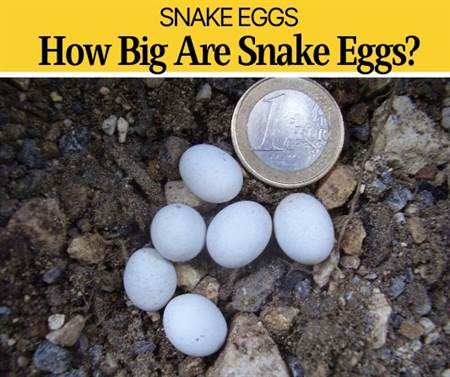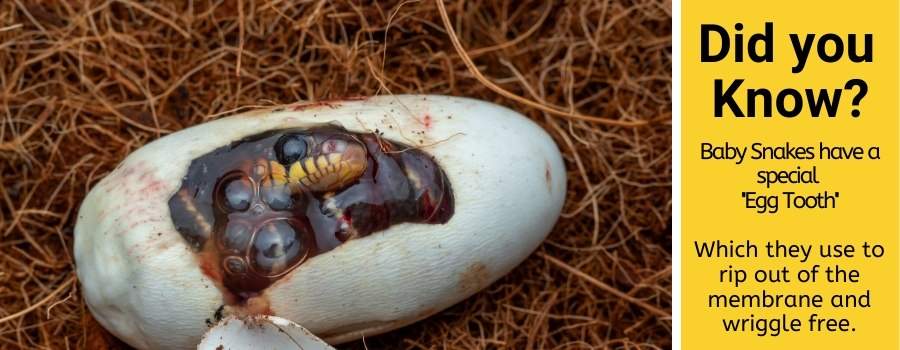 Snake eggs vary in size based on the type of snake that lays it.
Snake eggs vary in size based on the type of snake that lays it.
Though most snake eggs are similar in shape, color, and texture,
How large exactly are typical snake eggs?
Also we will see What snakes lay which type of eggs, where do they lay them, and do they all lay their eggs.
How Big Are Snake Eggs?
Snake eggs vary in size based on the size of the snake that lays the egg. For smaller snakes this would be around 25-30mm (around an inch) , for larger snakes the eggs can get as large as 55-75mm (2 or 3 inches) , The larger the snake the larger their eggs.
Some snakes carry their eggs inside of them rather than laying them in a nest, so you don’t actually see their eggs.
In this article we will compare the size of different snake eggs, see what color they are, are they soft or hard as well as find out where do the snakes lay their eggs and what to do if you have found snake eggs.
How Big Are Ball Python Eggs
Ball python eggs very between 71mm and 96mm in length (3-4inches) Python eggs also vary in weight between sixty-five grams and one hundred and three grams in weight per egg.
One ball python may lay as many as eleven eggs at one time, but commonly lays at least six.
How Big Are Brown Snake Eggs
Brown snake eggs are about five centimeters long. (2inches) Brown snakes bury their eggs in the ground, most often in dirt. Brown snakes search for soft dirt that they can use their body to push dirt out of the way to lay their eggs and then easily use their bodies to drag it back over their eggs.
The patch of dirt they most often choose is a location that isn’t heavily trafficked and is either warm and dry or moist and warm.
How Big Are Grass Snake Eggs
Grass snake eggs are between 25mm and 30mm in length. (1-1 1/4 inch) Grass snakes most commonly lay their eggs in compost piles or in rotting vegetables.
These locations generate heat naturally which the eggs need to survive. These locations require little to no digging and provide ample protection.
How Big Are Garter Snake Eggs
Garter snake eggs are between 58mm and 76mm in length. (2.5-3inches) Garter snakes, unlike most other snakes, do not bury their eggs.
Instead, garter snakes carry their eggs inside their abdomen. Rather than using the ground, environmental products, or vegetation to incubate their eggs, their bodies act as an incubator for their eggs until they hatch.
Garter snakes are considered to have live births because of the fact that they carry their own eggs until the baby snakes hatch and emerge from the mother’s body.
Garter snake is probably the most common snake you will find in North America.
How Big Are Black Snake Eggs
Black snake eggs are a whopping inch and three-quarter to two inches in length (2.5-5cm). Rotting logs, vegetation, or animal manure serve as ideal incubation locations for black snakes.
Black snakes seek out vegetation that they can crawl inside like a rotten pumpkin or a cow-pie to lay their eggs inside rather than the work of digging out a shallow hole like some other snakes prefer.
Related: Do Black Snakes Keep Copperheads Away?
How Big Are Rat Snake Eggs
Rat snake eggs are roughly an inch in length (2.5cm) Rat snakes use hollowed out or fallen trees, manure piles, compost piles, and sawdust piles as their ideal incubation sites for their egg nests.
Rat snakes most often chose warm locations that are not disturbed often. They most often look for elements in their natural environment such as a manure pile outside a barn or a pile of saw dust near a workshop.
How Big Are Corn Snake Eggs
Corn snake eggs are between an inch and a half and two and a half inches in length (3.5-5.5cm ) Their eggs are often half an inch to an inch around as well. Corn snakes seek out warm wet areas to incubate their eggs.

Where Do Snakes Lay Their Eggs?
Snakes that lay their eggs in nests for incubation until they hatch choose places that are at least somewhat protected and a place that generates and attracts heat.
Snakes choose warm soft dirt, manure piles, rotting vegetation, composting piles, and naturally created shelters like fallen trees, rotten logs, and under leaf piles to lay their eggs.
Those sites generate heat that is naturally produced through decay, like living trees as they rot out, the heat a compost pile generates as the food degrades and rots into dirt, the heat manure has naturally from the animal that it came from which is sealed inside as the manures outer shell hardens and traps heat inside, and so on.
Places like this provide the heat that a coldblooded snake egg needs for the baby snake to incubate, come to term, and eventually hatch from its egg. Depending on the type of snake, it can also provide a newborn snake with a food source.
Read also: How Do Snakes Make Holes In The Ground
What Color Are Snake Eggs?
Snake eggs are remarkably similar in color and shape. The main thing that differs from snake to snake is the size and weight of an egg.
A healthy snake egg is soft, unlike a bird egg. It will have a leathery texture and it will be firm, but soft. You know a snake egg is healthy when it has a white creamy color to it.
If a snake egg is not healthy it will appear a gray, yellow white, or even greenish in color. It will be very squishy and have little to no firmness or bounce-back when squeezed gently.
A blue or green tint to a snake egg is am indicator that it has been poisoned. Poisoning can either be either natural or caused by harmful agents that effected the egg in the nest, or in rare cases something the female snake came in contact with.
Are Snake Eggs Soft or Hard?
Snake eggs are not hard like a chicken egg or other bird eggs. Animals that sit on their eggs to keep them warm are the ones that have eggs with hard shells.
Animals like snakes, which get their warmth from the environment around them, lay eggs that have a soft shell.
This soft shell allows the egg to absorb heat from the area around it, such as dirt and decaying plant life.
It also allows the egg to give a little when the mother moves around her eggs while laying them. When snakes hatch, the soft shell also offers an easier escape for weak, newborn snakes.
What to Do with Snake Eggs
If you find snake eggs, it is best to either leave them alone or to contact a wildlife conservationist or snake professional to remove the eggs.
Removing the eggs, yourself can damage of even kill the snake.
You also risk getting hurt if the mother snake is near by protecting her eggs or in the event that the snakes inside those eggs are poisonous.
Baby snakes have no impulse control and therefore if they were to hatch while you are trying to move them you could end up dosed with a lethal amount of venom.
Snakes do not develop control of the amount of venom they inject into a predator or prey until they reach maturity.
Do Snake Eggs Look Like Chicken Eggs?
No, snake eggs do not look like chicken eggs. In fact, snake eggs do not look at all like the eggs of any animal that uses its body to heat the eggs while they are incubating.
Chicken eggs and other bird eggs have hard shells because their mothers or fathers sit on them until they are ready to hatch.
Because they use body heat to warm their eggs and the weight of their bodies are thrust onto the eggs, bird eggs have hard shells. Bird eggs have a roundish shape to them, and many have a tapered rounded-off tip on one end.
Snakes on the other hand are cold blooded and their mothers do not sit on them to keep them warm. Rather snake eggs have a rubbery shell that bounces back when pressed on.
They are also leathery to the touch to provide some durability and protection. These soft shells allow the heat from their surroundings to enter the egg and warm the baby snake inside.
Snake eggs are most often oblong, sort of oval with blunter ends.
Related Topics:
Do Snakes Bury Their Eggs?
Many snakes that lay their eggs bury them. That may mean burying them in the dirt, compost, or otherwise moist ground.
Though some snakes lay their eggs inside rotting trees, under foliage, in compost or manure, or in similar warm, moist, and protected places.
How Do You Know If A Snake Egg Is Bad?
Most often you can tell that a snake egg is bad when it is off white or light caramel in color, the texture of the egg is less leathery and more shiny, and the texture of the egg is less springy and more squishy.
Additionally, If a snake egg has come in contact with some form of toxin or poison the egg may also take on a light green or blue pigment.






